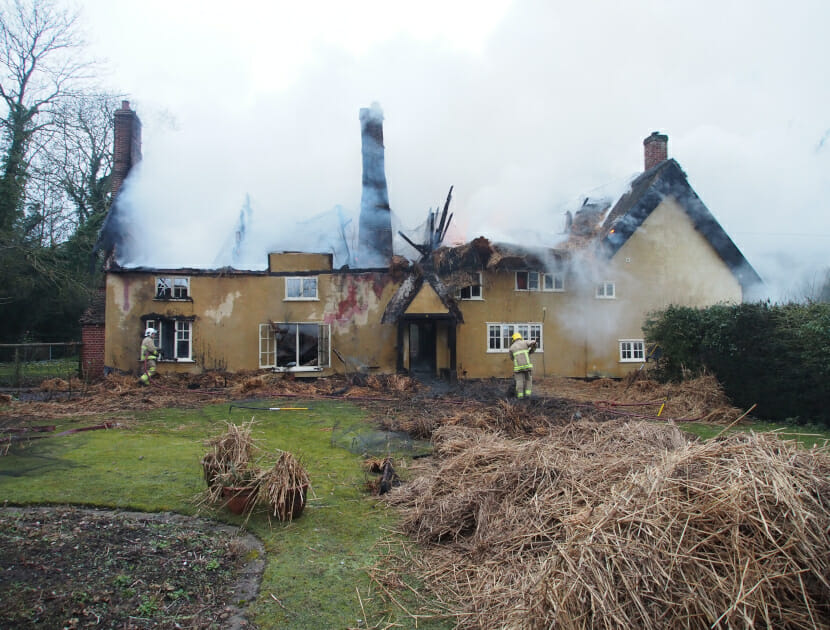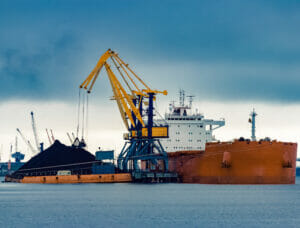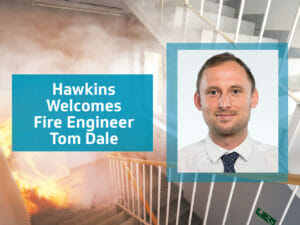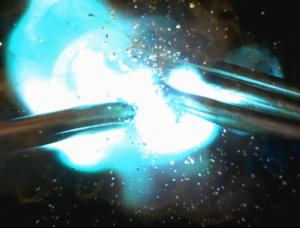Hawkins investigates around 30 fires each year involving thatched properties, although the number of incidents can vary significantly from year to year. Fires involving thatched roofs are normally devastating, resulting in significant emotional distress for homeowners and substantial financial losses for insurers. Most thatched properties are listed and therefore reinstatement works are often protracted and require close collaboration with local conservation officers.
Fires involving thatched roofs can start for a variety of reasons, but Hawkins’ experience is that most thatch fires are linked with chimneys, and that the vast majority of those incidents also involve the use of wood burning stoves. The installation of stoves in thatched properties has become widespread in recent years because they are seen as a more attractive alternative to open fires due to their appearance, efficiency and heat output in properties that are often cold and draughty.
Hawkins has seen a significant increase in thatched roof fires since wood burning stoves have become more common and yet the wider public’s understanding is often that the installation of a good quality stove and flue liner inside the existing chimney will help to reduce the risk of fire, when compared to an existing open fire. However, the thermodynamic operation of wood burning stoves actually increases the likelihood of a burning ember with sufficient energy to start a fire, being released from the top of the chimney, and landing on the surface of the roof.
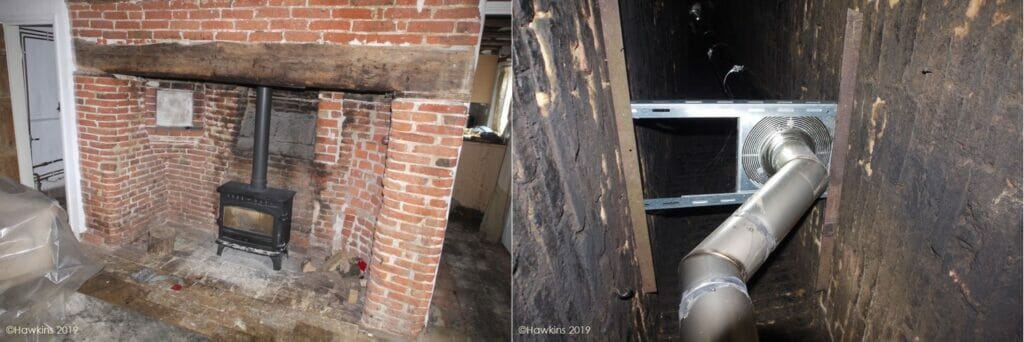
It is necessary to consider heat transfer mechanisms through chimney brickwork when investigating thatch fires involving the use of wood burning stoves. The air around a flue liner inside the chimney stack will become warm while the stove is in use, and therefore any defects in the chimney brickwork at thatch level could pose a risk. However, in Hawkins’ experience a burning ember being released from the chimney and igniting the surface of the roof is a much more common ignition mechanism.
The witness information provided during the investigation of thatch fires and wood burning stoves often follows a very similar pattern. Homeowners are normally not aware that anything is wrong until there is a knock at the door from a passer-by who has discovered the fire. Moments of greatest risk are often shortly after the stove has been lit, after fresh fuel has been added or after the ventilation controls have been adjusted, potentially increasing the strength of updraught. When homeowners first go outside, they routinely describe seeing flames coming from the surface of the thatch a short distance downwind of the chimney.
Hawkins has also found quite strong correlations between the time of year, or weather conditions, and thatch fires. Fluctuating weather conditions probably explains the variation in the number of fires we see from one year to the next. From the end of February through to early April is often a very busy time of the year for thatch fires, and any period of dry, sunny weather during those weeks often leads to a spike in the number of incidents. At that time of year the nights are often still cold thus enticing the continued use of the stove, but the days are longer and therefore a period of settled weather can dry the surface of the thatch, making it more susceptible to ignition by a burning ember.
Spark arrestors can be fitted to chimney outlets to capture burning embers. However, arrestors can become contaminated with tar and those deposits are also at risk of ignition, which can then result in large quantities of burning material raining down onto the surface of the roof. It is therefore necessary to ensure that spark arrestors are cleaned regularly, however this cleaning is often impractical due to difficulties with access. More recently, some insurers have stipulated that arrestors should be removed altogether.
Insurers of thatched properties also normally require any chimneys and flue liners to be swept regularly. This is critical in reducing the risk, because a fire involving tar and soot deposits inside a flue liner will result in a significant quantity of burning material being ejected from the chimney. Using well-seasoned wood will also reduce the rate of deposit build up inside the flue. Hawkins’ investigators are experienced in collecting evidence relating to policy compliance. In addition to policy conditions associated with both chimney sweeping and spark arrestors, insurers of thatched properties routinely require:
- Thatched roofs to be regularly inspected and maintained
- Smoke detectors to be located on all floors of the property (including inside any loft),
- Electrical installations to be tested
- Fire extinguishers to be kept inside the building
The installation of wood burning stoves and other solid fuel appliances is notifiable work under the Building Regulations Part J. Guidance relating to the installation of solid fuel appliances is detailed within Approved Document J (ADJ). The building regulations are not retrospective, but for new installations, ADJ specifies: the size and type of flue liner that should be used; the minimum distance from the surface of a flue to combustible materials; and the minimum height of the chimney outlet above the surface of ‘easily ignitable roof coverings‘ (e.g. thatch). Most reputable installers of wood burning stoves will be registered with the Heating Equipment Testing and Approval Scheme (HETAS), who are the industry body concerned with the installation of solid fuel stoves.
In terms of the risk associated with burning embers igniting the surface of the roof, the most important aspect of ADJ is the location of the chimney outlet. It states that the outlet should be located at least 1.8 m above the surface of the thatch and, if the outlet is situated beneath 0.6 m above the ridge of the roof, it should be located at least 2.3 m horizontally from the ridge line or the surface of the roof. Whilst compliance with ADJ does not eliminate the risk, it is clearly the case that when there is greater distance between the flue outlet and the thatch, it is less likely that an ember released from the chimney will have sufficient energy to start a fire by the time it lands on the roof.
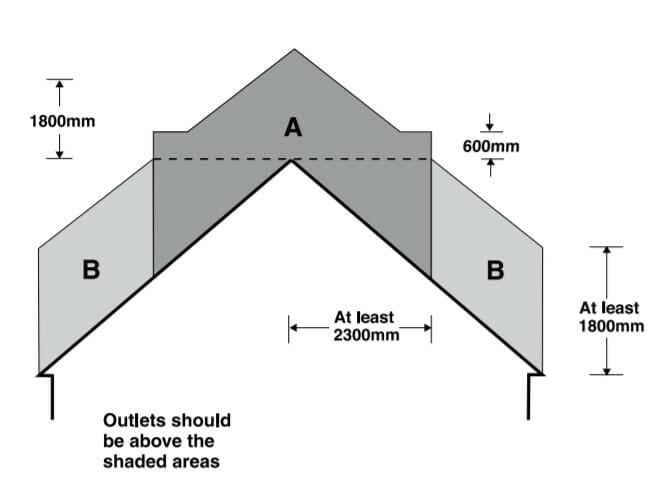
It is sometimes not possible, due to listing constraints, to increase the height of the chimney brickwork when a new stove and flue are installed, but the provision of a tall chimney pot can often ensure compliance with ADJ. Post-fire investigations can normally establish the position of the chimney outlet relative to the surface of the thatch, even when the roof has been destroyed, by measuring the distance between the outlet and lead flashing that remains attached to the chimney. A CCTV examination or the removal and inspection of the flue liner can also assist in determining whether or not a flue fire might have occurred.
ABOUT THE AUTHOR
Mark Turner has a degree in Materials Science and Engineering from the University of Sheffield and a Masters in Fire and Explosion engineering from the University of Leeds. Before joining Hawkins, he worked as a Project Engineer at one of the UK’s leading engineering investigation companies. Specialising in non-destructive investigation techniques, Mark worked within a wide range of civil engineering environments, which included carrying out detailed electromagnetic surveys of roads, railways and structures.
